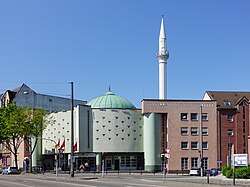| Yavuz Sultan Selim Mosque | |
|---|---|
Yavuz-Sultan-Selim-Moschee | |
 | |
| Religion | |
| Affiliation | Islam |
| Location | |
| Location | Mannheim, Germany |
| Geographic coordinates | 49°29′39″N8°27′41″E / 49.49417°N 8.46139°E |
| Architecture | |
| Type | mosque |
| Completed | 1995 |
| Minaret(s) | 1 |
| Website | |
| www.ditib-ma.de/ | |
The Yavuz-Sultan-Selim Mosque (German : Yavuz-Sultan-Selim-Moschee) is a religious building in Mannheim, Germany, named for Selim I. Until 2008 it was the biggest mosque in Germany, and attracts up to 3,000 Muslims every weekend. [1]
Since the mosque was opened in 1995, Muslim shops and youth centers have become a magnet for the Muslim community. [1]
